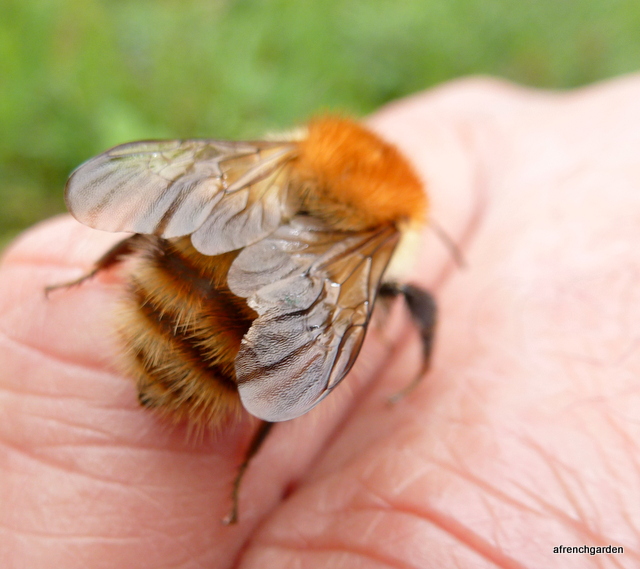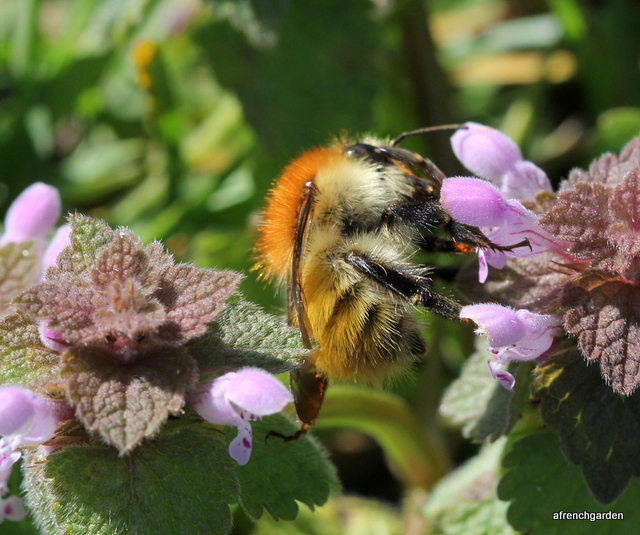It all started when I saw this bumble bee on my winter flowering honeysuckle on 12 December 2016. Usually I see only the B. terrestris (queens and workers) and the honey bees just now. I recognised it as a bumble bee that I see frequently around here in the spring and I thought I would have another go at identifying it.
This is me in April 2013 trying to get close up, to see if I could learn a bit more about bumble bees. This is what I thought must be pascorum, the commonest carder.
Going back to April 2011, my stripey common carder bee.
This is 6 March 2014 and these fluffy carders are a favourite – common or not.
In addition to these completely fluffy, stripey ones, I also see ones with this dark brown band around the top of their abdomen. It must be a brown-banded bumble bee, I thought in my naivety. However, these bees do not check out to Stephen Falk’s description in the “Field Guide to the bees of Great Britain and Ireland”. It was at this point I gave up going further with bumble bees.
I have now compared Bombus humilis in Atlas Hymenoptera Les bourdons de la Belgique and although B. humilis has now all but vanished in Belgium, one of the three types of examples (yes, three) looks very much like my brown banded bee.
I must admit that the three types of B.humilis in the Atlas Hymenoptera do not look like the same bee to me which leads me again into despair of the variations of colourings in bumble bees.
So what should my conclusion be? Return to my “give up” position for identification? Yet, The Bumblebee Conservation Trust in the U.K. encourages amateurs to get involved.
I do not want to identify bees like a train spotter to increase my list but I think it is very unlikely that anyone else has ever tried to identify a bee in this area. I would have liked to make an attempt, however crude, to quantify the diversity around me but perhaps this is not possible and samplings must be left to the experts.






I think some of the harder species need to be identified by taking a sample and looking under the microscope. Have you tried sending your photo to Bwars? Their Facebook page has lots of people willing to help with IDing.
LikeLiked by 1 person
I have tried ispot but (quite correctly) people do not want to go to species level with just a photograph. I have never examined any bees with a microscope, just chilled them for a photograph and released them. I am going to have to come to terms with a proper examination. However, I feel I have an additional problem with the difference between common English and French bees. There is far more literature and help for identifying English bees. Amelia
LikeLike
I agree with Emily. Join the forum at BWARS and toss it about.
You could also try catching a few. Bumblebees are relatively easy to capture in a small clear jar. You come up behind them and scoop them into the jar. Have a wad of kitchen paper or a piece of foam to form a stopper and to slide down the jar so the bee is not harmed but can’t move. Then look at it carefully using an illuminated loupe (a small magnifying eyepiece with an LED). A 10x and/or 20x should be enough.
When I did my bumble bee module at uni we were taught to primarily scrutinise carder bees for black hairs (unless we were keeping the specimen, then it would be sexual organs extracted from the dead bee). Their presence and where they are on the body should give an ID. The difficult bit is that on some specimens you are talking about 2-3 black hairs in all that ginger. You have to look with the light in the right direction and from all angles. That’s why IDing the little blighters from photos is tricky. Black hairs can look pale, pale hairs can look black, in photos and from certain angles when you have the specimen in your hand.
Don’t give up. You have excellent observational skills, patience and know to avoid ‘seeing what you want or expect to see’ in order to make the best possible ID. This is a very difficult group, with one very common species and two rare. It’s obvious to me that you have at least two of them, and I wouldn’t discount all three. The answer to your question above is ‘Extremely!’ I’m afraid.
I’ll send you the relevant bits of Ted Benton’s key. Ted’s book on bumble bees, in the New Naturalist series, is the bible. It has lots of useful tips on behaviour as well.
LikeLiked by 1 person
Thanks for your comment Susan, I learnt a lot from it. Amazing that just a couple of differently coloured hairs could confirm the species.
LikeLiked by 1 person
Thank you for your encouragement. I had never heard of this method for examining bumblebees but I can imagine trying it. What do you think of the different forms of bees in U.K. and France? For example, my Anthophora plumipes females are not black but pale grey, like the males. It is very difficult to tell apart the B. lucorum and terrestris (I don’t try). However, this spring I would like to catch some of the enormous queens I see moving like barrage balloons to land heavily on the flowers just to check out that they are all hortorum. With your method it might be possible. Thank you. Amelia
LikeLike
I like Susan’s bottle method.
LikeLike
I find the BWARS Facebook forum to be very helpful, friendly and hugely knowledgeable. I have had help in identifying quite a few species from photographs and on several occasions my guess has been incorrect but there is no bad feeling at all. I thought the “rule” about carder bees was that if you could see abdominal black hairs it was B. pascuorum but that may just be in the UK.
LikeLike
I did not know about the BWARS Facebook forum so I will look at that. It is just that I have not seen mention of carders with this thick brown band that I see around here expect in http://www.atlashymenoptera.net/page.asp?id=160. , The bumblebees of Belgium and the other two types of B. humilis look very different. I have not found the quality of information on bees and bumbles here that is available in the U.K. Amelia
LikeLike
Here is an edited version of the relevant couplets of Ted’s key. I’ve left out bits that require microscopic examination or refer to diagrams. Pages 276-277 of British Bumblebees, chapter What Bumblebee is that?:
5(a) – tail white. Broad black band on the abdomen (variable amounts of yellow hair on abdominal segment 1, or 1 and 2). Lacking spine on tip of mid-metatarsus. B. hypnorum.
5(b) – Tail not white. May have no, a few, or dense band of black on abdomen. May have some or no black hairs on thorax. Go to 6.
6(a) – Some black hairs on abdominal segments 1-5 (may be extensive, or very few: check sides of segments 3 and 4, and hind margins of segments using 10x lens). At least some long corbicular hairs black. Go to 7.
6(b) – No black hairs on abdominal segments 1-5 (check with 10x lens). Go to 8.
7(a) – Hairs on ventral surface of thorax and abdomen and corbicular hairs all or mostly black. B. muscorum (form agricolae).
7(b) – Hairs on ventral surface not all or mostly black. B. pascuorum.
8(a) – No black hairs on thorax. B. muscorum.
8(b) – May have some black hairs on the thorax. Go to 9.
9(a) – Long corbicular hairs all black or a mixture of pale and black. Longer hairs on the dorsal edge hind metatarsus black. B. pascorum (pale forms).
9(b) – In queens, long corbicular hairs pale, with much smaller black ones. Longer hairs on the dorsal edge of the hind metatarsus brown (not black). B. humilis
He notes that small workers of these three species may be very difficult to distinguish.
To use the key you slowly and carefully work your way through the statements, moving on to where it directs you when the statement is true. It should work that in each couplet of statements one is true for your specimen and one is false. At some point you will finish at a couplet which gives you an ID.
LikeLiked by 1 person
…and I thought I was having a hard time with Northern Hemisphere warbler species, with their seasonal plumage & breeding breeding variations…
LikeLike
My sympathies, I do not even start to identify the birds. Amelia
LikeLike
Hi Amelia, last year I went on a Bumble bee identification course and Stephen Falk was one of the speakers, part of the course was spent in the grounds of Ryton Organic Gardens and our guide used plastic tubes, similar size to a specimen pot, (I cant remember the correct name) and then a loupe to observe more closely. I had a fantastic day but came away realising this is a job for life, not a days course. Stephen Falk is on twitter and I’ve seen him ID on there, it maybe worth sending him the photo for more help. Best wishes, Julie
LikeLike
I would so much like to meet Stephen Falk! I use his book on identifying British bees, which has helped me a lot and also his on line Collection of British bee photographs on Flickr. I agree that learning about bees is a job for life. Still I know more now than when I started (zero) and now my bumbles are going to be examined in a tube this summer. Amelia
LikeLiked by 1 person